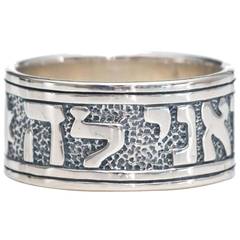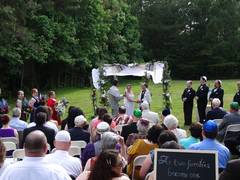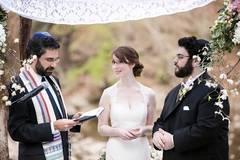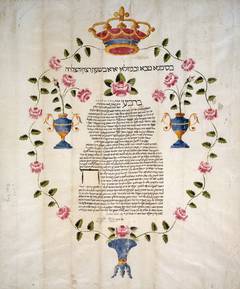Marriage is a momentous time, both as a milestone in a couple’s life and as a unique moment for their extended families. Beth Shalom honors and recognizes every marriage, whether it is between two Jews, a Jew and a non-Jew, a man and a woman, or two people of the same gender. Rabbi Edery officiates at interfaith ceremonies when the couple also plans to have Judaism present in their life.
We, at Beth Shalom, want to be a helpful resource to you as you make decisions about your wedding. Just as each couple is unique, we will help make your wedding ceremony comfortable and meaningful for you and your family. If you are interested in having a wedding at Beth Shalom or having a wedding officiated by Rabbi Edery, please contact our office to set up an initial conversation with our rabbi. At this meeting, you will discuss your wedding needs and plans and the special circumstances of your event. In order to guarantee our space and our rabbi’s availability, we suggest you speak with us before you commit to a date, time, and venue.
There are many rituals connected to a Jewish wedding, and thus, many decisions for each couple to make about the ceremony with the rabbi’s guidance. Here is a brief description of the Jewish wedding ceremony with some explanations of its rituals. Rabbi Edery will discuss with you the ways in which you may have your loved ones participate in the ceremony, as well as how you may include your own personal elements in it.
Huppah (Wedding Canopy)

The marriage ceremony begins as the couple enters the huppah—a marriage canopy (literally, in Hebrew, “covering”). The only rule about the construction of a huppah is that it be a temporary structure made by human hands. Other than that, it’s yours to create.
The huppah symbolizes the new home which the couple is now beginning to build. In this context, the appearance of the couple together under a huppah before an assembly who has come to witness the event, is in itself a public proclamation by them that they are now bonded together in marriage.
Formalizing the Marriage with a Ring
It is customary for one partner to place a ring on the index finger of the other partner's right hand and to recite a phrase in Hebrew that means, “By this ring, you are consecrated to me as my partner according to the tradition of Moses and Israel.” The partner then reciprocates the this gesture and pronounces the same words.
The words “according to the tradition of Moses and Israel” suggest the themes of covenant, community and continuity, which are expressed throughout the ceremony.

The Seven Blessings


Wine is an element of joy, which emerges from God’s creation—grapes—but only when people care for it and add to it their own creative work. This is a fitting metaphor for love and marriage. After praising God for the creation of the fruit of the vine, the blessings contain praise and thanks to God for creating the world, humanity, man and woman; we pray for the restoration of Jerusalem to a joyful and peaceful life; we ask God to grant perfect joy to these loving companions, as God did to the first man and woman in the Garden of Eden; and we hope for the day when all the world will know only happiness, love and joy.
The theme of creation in these blessings expresses the Jewish conception of marriage as a natural state and suggests that, by marrying, the couple now furthers God’s process of creation, initiated with the first couple in Eden. The blessings also allude to the future era when God’s purpose for humankind will be fully realized. By mentioning Adam and Eve in the Garden of Eden, and young men and women in a rebuilt Jerusalem, the couple’s union is placed in a wider context, within the people Israel and its history, and the striving to lead a life dedicated to higher human and religious values.
Ketubah
The ketubah is the traditional and legal marriage document, which is read aloud and signed.
The traditional (early Medieval) ketubah was conceived and used as a legal document. Modern texts emphasize the love and affection between couple and express their commitment to respect and cherish each other, and to build together a home guided by the values of Jewish tradition, such as study, justice, compassion, and the performance of good deeds.

Breaking the Glass
The next, and final, ritual element of the ceremony is the breaking of a glass. The origins and rationale for this tradition are uncertain. One interpretation suggests that the broken glass reminds Jews assembled at a joyous occasion of the destruction of Jerusalem and its Temple. Another suggests that the glass represents the hope that, just as the broken glass enters a new state from which there is no turning back, this couple will always remain in their married state. Others suggest that the shattered glass is a reminder to the couple of the fragility and the delicate nature of their relationship and love, urging them to be always caring and kind with each other. With this ‘step’, the ceremony is complete, and we wish the couple, “Mazel Tov!!” (good fortune, congratulations!).

